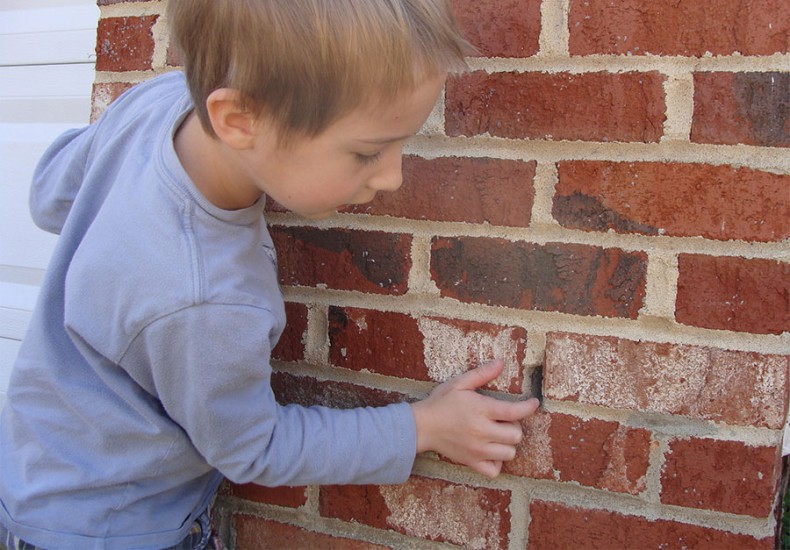Brick Wall Mystery, Solved
‘Weep holes’ keep exterior walls dry
By Hannah McKenzieThe author’s son investigates a weep hole on a brick home. Photo by Hannah McKenzie.
Q: There are gaps between some bricks around the base of my home. They seem to be intentional since they are all at the same height from the ground and the same distance from one another. What are they? Should I be caulking them shut?
A:Please put down the caulk and step away! Those gaps are called “weep holes” — a building code requirement that drains water out of brick exterior walls.
Typically, behind the brick is a 1.5-inch cavity or air space and then the wood structure. The outer surface of the wood wall is usually wrapped with a material like Tyvek® or foam insulation that keeps water droplets draining down and away from the wood and over metal flashing (imagine a continuous miniature children’s sliding board) that directs water to the weep holes. Despite different material and construction options, the gist is that brick walls built with cavities are designed to get wet and make water flow down and out through weep holes or evaporate.
Weep holes are spaced every two to four bricks in a horizontal run and are located above windows, doors and the ground. Most often, they are open vertical gaps. Alternatively, there can be cotton rope, plastic tubes, louvers or mesh installed to prevent pests while still letting water escape. It is easy for mortar — the cement‑like mixture between the bricks — to fall into the wall cavity during construction and prevent weep holes from working, which is one of many reasons skilled masons are essential for home construction.
Those gaps are called “weep holes” — a building code requirement that drains water out of brick exterior walls.
Some homes with brick cavity walls do not have weeps. Though not ideal, this situation is hard to remedy, and adding weeps is not suggested since they must be tied to flashing. Keeping the grout patched as it cracks over time is key to limiting the amount of moisture inside the cavity. For all houses, be on the lookout for signs of a moisture problem, such as mold, mildew or bricks with efflorescence (crystalline deposits) or spalling (flaking).
Efflorescence is when water moves through brick and evaporates when it reaches the sunshine. Salt dust left behind on the surface is a clue that weeps are not working or that an event has caused a lot of water to build up in the wall.
Spalling is when moisture has accumulated to a point that the bricks crumble. Freeze/thaw cycles can also contribute. In extreme cases, bricks become so soft that the surface crumbles like soil. A spalling foundation is extremely alarming but solvable.
Events that may cause water to build up inside a wall include:
- Blocked or missing weep holes
- Irrigation
- Excess humidity from a malfunctioning dryer vent or kitchen/bathroom exhaust fan
- Plumbing leaks from pipes, appliances or fixtures
- Air conditioning condensation drainage
- Damaged roofs, bricks, grout, windows or doors funneling water into the wall
There are so many tiny details that keep our homes comfortable, healthy and dry. Being aware of how our homes work and noticing problems can help us find solutions before the damage gets out of hand.
-
Ways to save energy
-
Share this story:






